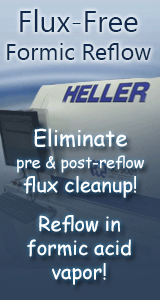Printed Circuit Board Assembly & PCB Design Forum
SMT electronics assembly manufacturing forum.
- SMTnet
- »
- Electronics Forum
- »
- DI water testing?
DI water testing?
Views: 8959
![]() I'm needing to use DI water for the first time. I called th...
- Aug 24, 2007
by
Dave
I'm needing to use DI water for the first time. I called th...
- Aug 24, 2007
by
Dave
![]()
![]()
![]() Dave,
First of all, distilled water is not DI water. It ...
- Aug 25, 2007
by
Michael
Dave,
First of all, distilled water is not DI water. It ...
- Aug 25, 2007
by
Michael
![]()
![]()
![]() In addition, plenty of good news on this link.
...
- Aug 25, 2007
by
GSx
In addition, plenty of good news on this link.
...
- Aug 25, 2007
by
GSx
![]()
![]()
![]() Is it sufficent to simply put meter probes in the water to g...
- Aug 25, 2007
by
Dave
Is it sufficent to simply put meter probes in the water to g...
- Aug 25, 2007
by
Dave
![]()
![]()
![]() Q1: Is it sufficent to simply put meter probes in the water ...
- Aug 27, 2007
by
davef
Q1: Is it sufficent to simply put meter probes in the water ...
- Aug 27, 2007
by
davef
![]()
![]()
![]() Dave,
I'd be skeptical too, with that response!
I've g...
- Aug 27, 2007
by
robgd3
Dave,
I'd be skeptical too, with that response!
I've g...
- Aug 27, 2007
by
robgd3
![]()
![]()
![]() Rob
When the little light goes red, your supplier changes...
- Aug 27, 2007
by
davef
Rob
When the little light goes red, your supplier changes...
- Aug 27, 2007
by
davef
![]()
![]()
![]() I have requested info on the disposable cartridge. I was to...
- Aug 27, 2007
by
Dave
I have requested info on the disposable cartridge. I was to...
- Aug 27, 2007
by
Dave
![]()
![]()
![]() Dave,
To tell you the truth, I couldn't tell you. I came...
- Aug 28, 2007
by
robgd3
Dave,
To tell you the truth, I couldn't tell you. I came...
- Aug 28, 2007
by
robgd3
![]()
![]()
![]() ...
- Aug 30, 2007
by
bmaheu
...
- Aug 30, 2007
by
bmaheu
![]()
![]()
![]() Rob
If your supplier replaces your carbon bed when the io...
- Aug 30, 2007
by
davef
Rob
If your supplier replaces your carbon bed when the io...
- Aug 30, 2007
by
davef
![]()
![]()
![]() OK, I've found out more on the disposable cartridge. It is ...
- Aug 31, 2007
by
Dave
OK, I've found out more on the disposable cartridge. It is ...
- Aug 31, 2007
by
Dave
![]()
- SMTnet
- »
- Electronics Forum
- »
- DI water testing?







